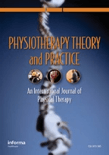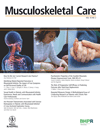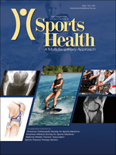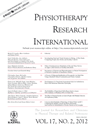
PHYSIOTHERAPY THEORY AND PRACTICE
Scope & Guideline
Leading the Way in Physiotherapy Research and Practice
Introduction
Aims and Scopes
- Clinical Rehabilitation Techniques:
The journal emphasizes clinical rehabilitation methods, exploring new and traditional techniques to enhance recovery in various patient populations, including those with musculoskeletal, neurological, and cardiopulmonary conditions. - Evidence-based Practice:
A core focus is on promoting evidence-based practice in physiotherapy, encouraging practitioners to utilize scientific research to inform their clinical decisions and improve patient care. - Multidisciplinary Approaches:
The journal supports interdisciplinary collaboration, showcasing research that involves physiotherapy alongside other healthcare disciplines to provide comprehensive care for patients. - Patient-Centered Care:
There is a strong emphasis on patient-centered approaches, highlighting studies that explore patient experiences, satisfaction, and the therapeutic alliance between physiotherapists and their clients. - Innovative Technologies in Physiotherapy:
The journal includes research on the integration of technology in physiotherapy, such as telehealth, virtual reality, and wearable devices, to enhance treatment efficacy and accessibility. - Pain Management and Rehabilitation:
A significant portion of the research addresses pain management strategies within physiotherapy, investigating the efficacy of various interventions for chronic pain conditions. - Educational Strategies in Physiotherapy:
The journal also covers educational research, focusing on the training and development of physiotherapy students and practitioners to improve the standards of care in the profession.
Trending and Emerging
- Telehealth and Remote Interventions:
The integration of telehealth in physiotherapy has surged, driven by the need for accessible care during and after the COVID-19 pandemic. Research increasingly focuses on the effectiveness of remote consultations and digital interventions. - Mental Health and Physiotherapy:
There is a growing recognition of the connection between physical and mental health, leading to increased research into how physiotherapy can address psychological aspects of patient care, especially in chronic pain and rehabilitation. - Personalized and Precision Rehabilitation:
Emerging studies emphasize personalized rehabilitation protocols tailored to individual patient needs and characteristics, moving away from one-size-fits-all approaches. - Integration of Technology in Rehabilitation:
Research on the use of wearable technology, gamification, and virtual reality in rehabilitation is on the rise, indicating a trend towards innovative solutions that enhance patient engagement and treatment outcomes. - Cultural Competence and Diversity in Care:
An increasing number of studies are examining the importance of cultural competence in physiotherapy practice, focusing on how therapists can effectively engage with diverse populations and address health disparities. - Chronic Disease Management:
There is a noticeable trend towards exploring physiotherapy’s role in managing chronic diseases, particularly in promoting long-term health and wellness strategies for conditions like diabetes and cardiovascular disease.
Declining or Waning
- Traditional Manual Therapy Techniques:
Research focused solely on traditional manual therapy techniques has seen a decrease, possibly due to the increasing emphasis on evidence-based practice and the need for more comprehensive, multimodal approaches. - Generalized Pain Management Approaches:
There is a noticeable decline in studies centered on generalized pain management strategies without a specific focus on individual patient experiences or tailored interventions, reflecting a shift towards more personalized care. - Historical Perspectives in Physiotherapy:
Fewer articles are being published that examine the historical development and evolution of physiotherapy practices, indicating a potential waning interest in the historical context of the discipline. - Single-Domain Interventions:
Research focusing exclusively on single-domain interventions (e.g., only strength training or flexibility) has diminished, as there is a growing recognition of the importance of multifactorial approaches to rehabilitation. - Acute Care Physiotherapy Studies:
Investigations specifically addressing acute care physiotherapy have become less frequent, possibly overshadowed by a broader focus on chronic conditions and long-term rehabilitation outcomes.
Similar Journals

Current Physical Medicine and Rehabilitation Reports
Fostering Global Dialogue in Physical Medicine and RehabilitationCurrent Physical Medicine and Rehabilitation Reports, published by SpringerNature, is an esteemed academic journal dedicated to advancing the fields of physical medicine and rehabilitation. With a focus on disseminating high-quality research and evidence-based practices, this journal covers a broad spectrum of topics including orthopedic medicine, sports therapy, and comprehensive rehabilitation strategies. While it currently holds a Q3 quartile ranking across several related categories, including medicine and rehabilitation, the journal aims to elevate its impact through open access to its content, fostering a global discussion amongst researchers, professionals, and students alike. Navigating the intersections of innovation and clinical application, Current Physical Medicine and Rehabilitation Reports serves as a vital resource for those seeking to enhance their understanding and practice in this dynamic field. With its evolving scope, the journal is committed to publishing studies and reviews that shape the future of rehabilitation and physical medicine practices.

Physiotherapy
Advancing the Science of RehabilitationPhysiotherapy, published by Elsevier Science Ltd, stands as a prestigious journal in the field of Physical Therapy, Sports Therapy, and Rehabilitation. Since its inception in 1945, this journal has been committed to advancing the practice and science of physiotherapy through rigorous peer-reviewed research, making significant contributions to both clinical practice and academia. With an impressive Q1 ranking and a Scopus percentile of 88th, it is widely regarded as a leading source of evidence-based information for professionals and researchers alike. The journal operates without an Open Access option, which ensures that it maintains the quality and integrity of the research it publishes while providing exclusive access to valuable insights for its subscribers. By focusing on diverse topics within its scope, including therapeutic techniques, rehabilitation strategies, and sports medicine, Physiotherapy continues to shape the future of physiotherapy practice and education, making it an essential resource for anyone invested in this dynamic field.

Musculoskeletal Care
Elevating Standards of Care for Musculoskeletal HealthMusculoskeletal Care is a prestigious journal published by WILEY, focusing on the multidisciplinary field of musculoskeletal health. With its ISSN 1478-2189 and E-ISSN 1557-0681, the journal has established itself as a vital resource for researchers, healthcare professionals, and students dedicated to the study and treatment of musculoskeletal disorders. Since its inception in 2003, it has maintained a strong reputation, achieving a Q1 ranking in Chiropractics and notable placements in other relevant categories, including Nursing and Orthopedics. The journal emphasizes the importance of evidence-based practices, innovative therapies, and collaborative research, making it essential reading for those involved in rehabilitation, sports medicine, and rheumatology. Although not an open-access journal, it remains widely accessible through academic institutions and professional organizations, contributing significantly to the ongoing discourse in musculoskeletal care and enhancing the quality of care provided to patients worldwide.

Musculoskeletal Science and Practice
Exploring the frontiers of physical therapy and rehabilitation.Musculoskeletal Science and Practice is a premier academic journal published by Elsevier that focuses on the latest advancements in the field of physical therapy, sports therapy, and rehabilitation. With an ISSN of 2468-7812 and an impressive ranking in the Q1 category for 2023, this journal stands out among its peers, being positioned at #69 out of 247 in Scopus rankings within the Health Professions sector, demonstrating a significant impact factor that reflects its importance in the domain. As a dedicated Open Access platform, it aims to disseminate high-quality research and clinical practices to enhance rehabilitation outcomes for patients. The journal, established in the UK and converging its focus from 2017 to 2024, serves as an invaluable resource for professionals, researchers, and students, enabling them to stay informed about innovative practices and evidence-based strategies in musculoskeletal health. With the increasing demands for effective rehabilitation methods in today's healthcare landscape, Musculoskeletal Science and Practice plays a crucial role in shaping the future of therapeutic interventions and advancing the knowledge base in the field.

Annals of Rehabilitation Medicine-ARM
Transforming Rehabilitation Practices with Quality ResearchAnnals of Rehabilitation Medicine (ARM), published by the Korean Academy of Rehabilitation Medicine, is a distinguished open-access journal dedicated to advancing the field of rehabilitation medicine since its inception in 1977. With its E-ISSN 2234-0653, ARM aims to disseminate high-quality, peer-reviewed research that reflects both the breadth and depth of rehabilitation practices. As of 2023, the journal ranks in the Q2 quartile within the Rehabilitation category, placing it among the top half of journals in this domain, and it holds a respectable position in the Scopus rankings, being 70th out of 161 in the discipline. This journal emphasizes the importance of innovative research and clinical practices that improve patient outcomes in rehabilitation settings. Researchers, clinicians, and students alike will find valuable insights and the latest developments in rehabilitation science, enhancing their understanding and practice through its accessible content.

Physiotherapy Practice and Research
Empowering practitioners with cutting-edge findings.Physiotherapy Practice and Research is a pivotal journal published by IOS PRESS that focuses on the dynamic field of rehabilitation and physiotherapy. Since its inception in 2009, this journal has provided a scholarly platform for researchers, clinicians, and students to disseminate innovative findings and practical applications in occupational therapy, sports medicine, and rehabilitation sciences. Although the journal currently holds Q3 and Q4 rankings in several categories, including occupational therapy and physical therapy, its impact in fostering research collaboration and informing practice is becoming increasingly important in advancing patient care and rehabilitation outcomes. With an ongoing commitment to open-access principles, the journal welcomes original research and review articles that address contemporary challenges and emerging practices within the field. As the journal continues to evolve, it aims to engage more deeply with the global research community, unlocking vital discussions that shape the future of physiotherapy.

Sports Health-A Multidisciplinary Approach
Pioneering Multidisciplinary Approaches for Enhanced Sports PerformanceSports Health: A Multidisciplinary Approach (ISSN: 1941-7381; E-ISSN: 1941-0921), published by SAGE Publications Inc, stands as a premier resource in the domains of Orthopedics, Sports Medicine, and Physical Therapy. With an impressive Q1 ranking in both Orthopedics and Sports Medicine and Physical Therapy, Sports Therapy and Rehabilitation for 2023, this journal is highly regarded for its contributions to advancing knowledge and practice in sports health. Covering research from 2009 to 2024, it facilitates interdisciplinary discourse among researchers, practitioners, and students seeking to enhance patient outcomes and optimize rehabilitation strategies. The journal's rigorous peer-review process ensures that only the highest quality research is presented, making it an essential read for anyone committed to the field of sports health.

Physiotherapy Research International
Exploring New Frontiers in Physical Therapy Research.Physiotherapy Research International is a leading journal in the fields of Physical Therapy, Sports Therapy, and Rehabilitation, published by WILEY. With a commendable impact factor reflecting its significant contribution to the profession, this journal enjoys a competitive position, ranking in the 66th percentile and 84th out of 247 in its category according to Scopus. The journal encompasses a broad scope of research from 1996 to 2024, addressing critical advancements in physiotherapy and rehabilitation practices. Although it is not an Open Access journal, it provides valuable insights and research findings that foster knowledge and innovation among practitioners and researchers alike. As a Q2 category journal in its field for 2023, Physiotherapy Research International aims to facilitate the dissemination of high-quality research aimed at improving patient outcomes and guiding clinical practice. It serves as an essential resource for those committed to advancing the science and practice of physiotherapy.

Frontiers in Rehabilitation Sciences
Driving knowledge exchange in the evolving field of rehabilitation.Frontiers in Rehabilitation Sciences, published by FRONTIERS MEDIA SA, is an innovative open-access journal that has been committed to advancing the discipline of rehabilitation science since its inception in 2021. The journal aims to serve as a platform for researchers, clinicians, and students interested in disseminating high-quality research and insights that drive practice and policy in rehabilitation and physical therapy. With an E-ISSN of 2673-6861, it fosters interdisciplinary collaboration, tackling topics that range from therapeutic interventions to sports rehabilitation and beyond. As part of the Frontiers family, the journal employs cutting-edge open-access policies that ensure widespread dissemination and visibility of research findings. Although it is currently ranked within the lower quartiles based on Scopus rankings, the journal provides an invaluable opportunity for emerging scholars to publish their work in a rapidly evolving field. By sharing knowledge and fostering dialogue among scientists and practitioners alike, Frontiers in Rehabilitation Sciences plays a crucial role in shaping the future of rehabilitation methodologies and improving patient outcomes.

Archives of Physiotherapy
Leading the Charge in Rehabilitation and Sports TherapyArchives of Physiotherapy is a prominent peer-reviewed journal published by SPRINGERNATURE, dedicated to advancing knowledge and practice in the fields of physical therapy, sports therapy, and rehabilitation. Since its inception in 2015, this Open Access journal has contributed to the dissemination of research that informs clinical practice and educates future professionals. With a commendable impact reflected in its Scopus rankings—placing it in the 72nd and 69th percentiles for Rehabilitation and Physical Therapy respectively—Archives of Physiotherapy stands as a critical resource for researchers, practitioners, and students striving to stay at the forefront of innovative therapy techniques and rehabilitative practices. The journal’s strategic focus on emerging trends and evidence-based methodologies makes it an invaluable platform for scholarly exchange and collaboration in the evolving landscape of healthcare. Now, serving audiences across the globe from its base in the United Kingdom, it is positioned to impact the future of rehabilitation science during its converged years from 2015 to 2024.